
 |
Overview of the 1998-99
|
| The Program | On January 9, 1998, the Governor submitted his proposed 1998-99 budget plan. This brief discusses the proposal's major features and some of the key issues and considerations that the Legislature will face in crafting a budget which reflects its priorities. |
| LAO Findings |
|
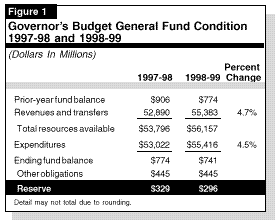

| Figure 3
Key Programmatic Features of the Budget Proposal | |
| Taxes | Includes no new tax-related changes. |
| Education | Provides funds for lengthened K-12 school year. Proposes funds to higher education to cover fourth year of Governor's "compact" with California State University (CSU) and University of California (UC), as well as enrollment growth. |
| Welfare | Makes permanent the California Work Opportunity and Responsibility to Kids (CalWORKs') 4.9 percent grant reduction and permanently suspends certain welfare COLA adjustments. Uses federal funds to support large increase in spending for CalWORKs' job training and child care services. |
| Infrastructure | Proposes $7 billion in bonds for K-12 school facilities, higher education, correctional facilities, local infrastructure bank, resources, and other purposes. |
| Corrections | Proposes full funding for caseload increases. |
| Other Programs | Eliminates renters' credit. Provides funds for equivalent of 3 percent COLA for state employees. Pays off interest relating to Public Employees' Retirement System (PERS) lawsuit. |
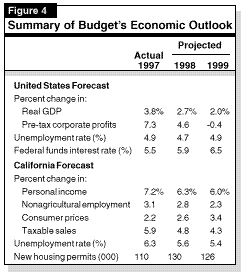
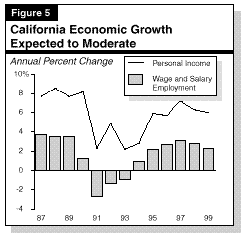
The budget's economic forecast is generally consistent with recent projections made by other economists and our own forecast made last November, although certain developments have occurred since the budget forecast was prepared.
Asian Financial Problems. The unsettled financial situation associated with Asian economies clearly represents some downside risk to the budget's economic forecast. The forecast already has incorporated downward adjustments for the Asian situation through December, especially in its projections for export-related industries. However, conditions in the region have continued to deteriorate since the budget forecast was prepared, posing additional risk to California's outlook.
Recent Housing Market Strength. On the positive side, recent favorable housing market developments are working to improve the state's near-term economic prospects relative to the forecast. For example, home sales are booming, in part spurred by recent reductions in interest rates, and new construction activity is climbing.
We will be providing the Legislature with our own updated economic forecast in February's Perspectives and Issues (P&I), which will incorporate developments since the budget was prepared.
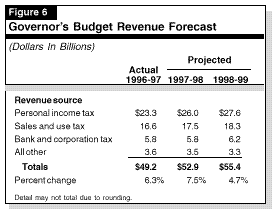
The budget does not contain any new tax-related proposals, but the revenue forecast does incorporate the effects of the state's 1997 tax relief package, including an increased personal income tax dependent exemption credit. The fiscal effect of this package is to reduce revenues by $189 million in 1997-98 and $593 million in 1998-99 (reaching $1.1 billion in 1999-00). In its absence, 1998-99 revenue growth would have been modestly higher 5.5 percent.
The budget also assumes $85 million in 1998-99 revenues from federal adoption of a tax offset program (this program also has been assumed, but not adopted, in previous years).
How Is Revenue Growth Allocated? Figure 7 (see page 6) shows how the budget proposes to allocate the $2.5 billion in projected 1998-99 revenue growth. Somewhat over 40 percent ($1.1 billion) goes for K-12 education. Of the remainder, $0.6 billion goes to higher education, $0.4 billion goes to health and social services, and $0.3 billion goes to corrections-related spending. The final $0.1 billion is a net figure which includes a variety of offsetting elements, including a drop of over $0.7 billion in payments to the PERS fund (reflecting reduced payments in the budget year associated with the PERS court settlement), an increase of $0.5 billion for trial court funding (due to the financial restructuring agreement), $142 million for a state employee pay increase and over $100 million for state infrastructure.
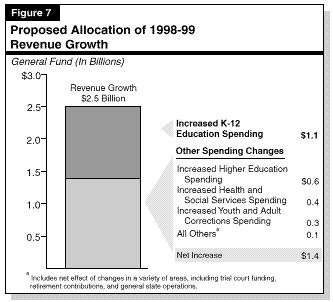
Recent Cash Trends Have Been Strong. In December, cash receipts exceeded the 1997-98 Budget Act forecast by over $650 million, more than offsetting the revenue softness that occurred earlier in the year. The Department of Finance, however, did not have this information fully available when it prepared the budget revenue forecast.
We Believe Revenues Are Understated. Our November revenue forecast for the current and
budget years combined is over $500 million above the new budget estimate. The recent
strength of year-end receipts, along with the continuing strength of withholding receipts,
suggest that the revenue trend is at least as strong as our November projection. Given the way
the Proposition 98 formula works, it also appears that most of these added revenues could
be used for non-Proposition 98 purposes. Thus, the Legislature will have the flexibility
to allocate such additional monies to what it feels are the state's highest priority needs. We will
be providing the Legislature with our revised revenue forecast in our February P&I, which will
take account of recent cash trends.
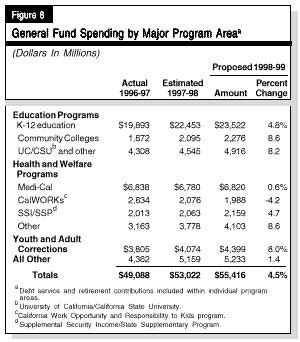
General Fund spending on CalWORKs-related services is projected to decline while spending on several smaller health and welfare programs (specifically, In-Home Supportive Services, Regional Centers, and Developmental Centers) is proposed to increase significantly.
How Are the New Monies Spent? Figure 9 (see page 8) displays the major uses of these
additional funds. The largest share $657 million (33 percent)would provide a
2.2 percent COLA for district and county office revenue limits as well as for most
categorical programs. General purpose and categorical program funding for the projected
1.7 percent growth in the student population accounts for $507 million, or
25 percent of available funds. The proposal to increase the length of the school year to
180 days (also known as "staff development day buy-out") accounts for another
$350 million, or 17 percent. Major increases for child care programs
($168 million), deferred maintenance ($135 million), and various other categorical
programs use the remaining 25 percent of new
K-12 funds.
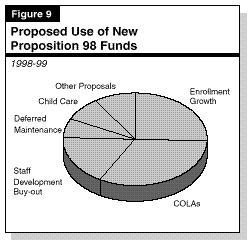
The COLA Issue. The significant amount of discretionary funds that are available in 1998-99 is due in part to a proposal by the Governor regarding the K-12 revenue limit COLA. Because of a revision of past-year data in the inflation index used to calculate this adjustment, existing law calls for a 4 percent COLA. The budget, however, proposes to fund a 2.2 percent COLA, which costs about $500 million less. The 2.2 percent figure represents inflation over the prior year. We will review both the requirements of current law and the Governor's proposal, and comment on them in our upcoming Analysis.
Other Proposals. Figure 10 identifies several additional major K-12 education proposals. These proposals would have costs for local school districts. The dollar impact on the proposed state budget, however, is minor. The Opportunity Scholarship program is even projected to save the state's General Fund about $40 million. This is because the budget assumes that all 15,000 students using the scholarships would attend private school. This reduces the minimum funding guarantee under Proposition 98 by about $92 million. The budget proposes to spend $52 million in non-Proposition 98 General Fund monies (or about $3,500 per student) for the scholarships.
| Figure 10
Other Major K-12 Proposals | |
| Opportunity Scholarships | Allows 15,000 students attending the lowest performing schools in the state to attend a private school or other public school. |
| Instructional Minutes | Lengthens the school day at most middle schools and high schools by requiring schools to exclude the time between class periods (known as "passing time") from district calculations of instructional time. |
| Social Promotion | Prohibits students who cannot achieve a passing score on a state assessment test to proceed to the next grade. |
| Mandated Use of Lottery Funds | Directs school districts to use the projected $99 million increase in Lottery funds for textbooks. |
University of California and California State University. The budget proposes General Fund spending of $2.4 billion for UC and $2.1 billion for CSU in 1998-99, representing increases of 8 percent and 8.6 percent, respectively, from the current year. The budget provides funding for the fourth year of the Governor's compact with higher education. It also provides funding for additional enrollment at CSU, and the "buyout" of the 5 percent student fee reduction for UC and CSU required by legislation passed in 1997. The UC budget also includes planning funds for a tenth campus at Merced.
| Figure 11
Major Health and Social Services Proposals | |
| (In Millions) | |
| Proposal | Fiscal Effect |
| Permanently eliminate CalWORKs and SSI/SSP COLA's | -$123 |
| Make 4.9 percent CalWORKs grant reduction permanent | -151 |
| Enhance services for developmental centers and regional centers | 51 |
California Work Opportunity and Responsibility to Kids (CalWORKs). The budget proposes $5.9 billion from all funding sources for CalWORKs in 1998-99, including $2 billion from the General Fund. This is an increase of $307 million in total funds, but an $88 million reduction in spending from the General Fund. The contrast between increased total spending and declining General Fund spending is due to the fact that a significant portion of CalWORKs spending in the budget year is funded by a large carryover balance of unexpended federal Temporary Assistance for Needy Families block grant funds from the current and prior years. The budget proposes to (1) make permanent the 4.9 percent grant reduction, resulting in a General Fund cost avoidance of $151 million; and (2) permanently eliminate the statutory COLA, resulting in a General Fund cost avoidance of $71 million.
Supplemental Security Income/State Supplementary Program (SSI/SSP). The budget proposes General Fund expenditures of $2.2 billion in 1998-99, an increase of 4.7 percent over the current year. This includes funding to cover a 3.1 percent projected increase in caseload ($70 million) and an increase in the federal administrative fee ($18 million). The budget proposes to make permanent the suspension of the state COLA, resulting in a General Fund cost avoidance of $52 million in 1998-99. Recent caseload declines in SSI/SSP indicate that state costs in this program will fall below the amounts envisioned in the new budget estimate.
Medi-Cal. The budget proposes General Fund expenditures of $6.8 billion for the Medi-Cal Program, a 0.6 percent increase over the current year. This includes a current-year savings of $210 million, primarily due to caseloads that are declining more rapidly than anticipated when the 1997-98 budget was enacted. According to the budget estimate, total Medi-Cal caseloads will decline by 257,000 (or 4.8 percent) in the current year, with the bulk of the decline involving the CalWORKs caseload. In 1998-99, the budget projects that caseload will decline by an additional 148,000 persons, or 2.9 percent, resulting in a General Fund savings of about $100 million. An increase in the federal matching rate for Medi-Cal will save an additional $65.8 million. However, these savings will essentially be offset by increases in the cost and utilization of services. The budget does not propose any major new changes in the Medi-Cal Program.
Healthy Families Program. The budget includes a total of $64.5 million from the
General Fund in 1998-99 for the first year of operation of the new Healthy Families Program,
which provides health care coverage to children in families with incomes up to
200 percent of the federal poverty level. Of this total, the budget proposes
$33.3 million for the Managed Risk Medical Insurance Board to subsidize health
insurance for children in families with incomes above Medi-Cal limits, $25.2 million for
Medi-Cal eligibility expansions and outreach, and identifies $6 million in spending for
existing child health programs that will be included in the program. Together with federal
matching funds, total proposed spending for Healthy Families Program will be
$201 million. By the end of 1998-99, the budget estimates that the program will cover
201,000 children in the insurance program, and extend Medi-Cal coverage to an additional
101,000 children.
Regional Centers and Developmental Centers. The budget proposes to fund caseload increases and enhanced services for developmentally disabled persons. This includes $114.9 million ($95 million General Fund, including Medi-Cal reimbursements) for caseload and cost increases, $40.4 million ($34.7 million General Fund, including reimbursements) for regional center clients placed in the community, and $31.1 million ($16.5 million General Fund, including reimbursements) for the first year of a four-year expansion of staffing for the developmental centers.
In evaluating this proposal, we believe that the key issues for the Legislature to focus on are: (1) do the capital projects being proposed make sense and are they of high priority, (2) should bonds be used to finance them, and (3) how much debt service should future budgets be faced with? With regard to financial feasibility, we do not think this is a problem, in that the credit markets can easily absorb these bonds if their marketing is appropriately timed, and the state's debt-service ratio (currently 4.4 percent) would not rise above safe levels.
Public Employees' Retirement System. Spending for PERS drops from $1.7 billion in the current year to $1 billion in 1998-99. Spending for both years includes the impacts of the PERS court settlement. The 1997-98 total includes the $1.2 billion payment of deferred principal contributions to the fund. In 1998-99, the budget includes $310 million to cover the interest on these deferred payments.
Renters' Credit. This credit, which provides a refundable tax credit of $60 to single renters and $120 to married couples and heads of households, has been suspended in each year since 1993. Under existing law, the credit is scheduled to be reinstated in 1998. The budget proposes to permanently eliminate the credit, for a budgetary savings of $540 million in 1998-99.
Local Government. The budget proposes a $200 million general obligation bond issue along with $50 million in direct General Fund spending to fund an infrastructure bank. Other than this proposal, the budget does not include any major new initiatives relating to local governments.
Employee Compensation. The budget includes sufficient funds for a 3 percent salary increase for state employees, effective July 1, 1998. The budget indicates this money is to fund any forthcoming employee compensation changes arrived at for 1998-99 through the collective bargaining process.
Options for Using Additional Funds. Naturally, there are many different competing needs and priorities facing the Legislature in allocating any additional resources. One option worth considering would be to "beef-up" the General Fund's budgetary reserve to a more meaningful level, given that its proposed level is only a fraction of 1 percent of the budget, and even a modest economic slowing could cause a fall-off in revenues of several hundreds of millions of dollars in just a few months. Other options include funding certain pressing one-time capital outlay needs through direct appropriations, reforming local government finance, and addressing various other spending and tax-policy priorities. The key point is that the Legislature may have an unusual opportunity to set policies to address its own priorities based on revenues beyond that envisioned in the budget.
| Acknowledgements This report was prepared by Brad Williams and David Vasché, with the assistance of many others throughout the office. The Legislative Analyst's Office (LAO) is a nonpartisan office which provides fiscal and policy information and advice to the Legislature. | LAO Publications
To request publications call (916) 445-2375.
|